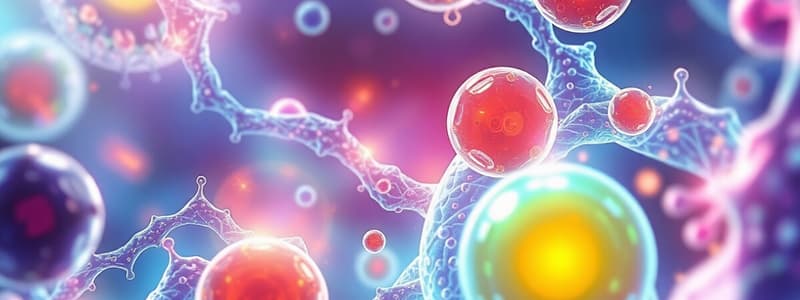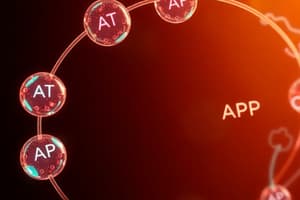Podcast
Questions and Answers
What is the role of checkpoints in the cell cycle?
What is the role of checkpoints in the cell cycle?
- To ensure that DNA is completely replicated before division
- To enhance the speed of cell division
- To prevent cells from entering cytokinesis
- To ensure cells only divide under appropriate conditions (correct)
Which statement accurately describes the process of cytokinesis?
Which statement accurately describes the process of cytokinesis?
- It occurs before mitosis and involves DNA replication
- It is the division of the cytoplasm in cell division (correct)
- It is the initial phase of cell division where chromosomes condense
- It is the stage where spindle fibers separate sister chromatids
How do allosteric effectors influence enzyme activity?
How do allosteric effectors influence enzyme activity?
- They bind to the active site, increasing substrate affinity
- They bind to sites other than the active site, altering enzyme conformation (correct)
- They increase the temperature, enhancing reaction rates
- They compete with substrates for the active site
Which type of enzyme inhibition occurs when a molecule inhibits substrate binding by attaching to the active site?
Which type of enzyme inhibition occurs when a molecule inhibits substrate binding by attaching to the active site?
What is one way that enzyme activity can be regulated chemically?
What is one way that enzyme activity can be regulated chemically?
What process do enzymes primarily facilitate in metabolic reactions?
What process do enzymes primarily facilitate in metabolic reactions?
Which statement accurately describes the outcome of mitosis?
Which statement accurately describes the outcome of mitosis?
What role does ATP play in cellular metabolism?
What role does ATP play in cellular metabolism?
What is a key feature of meiosis compared to mitosis?
What is a key feature of meiosis compared to mitosis?
How do feedback mechanisms regulate metabolic pathways?
How do feedback mechanisms regulate metabolic pathways?
What is a fundamental difference between catabolism and anabolism?
What is a fundamental difference between catabolism and anabolism?
Why is cell cycle regulation important?
Why is cell cycle regulation important?
What is the main function of mitochondria within eukaryotic cells?
What is the main function of mitochondria within eukaryotic cells?
Flashcards
Enzyme function
Enzyme function
Enzymes speed up chemical reactions in living things without being used up.
Enzyme specificity
Enzyme specificity
Each enzyme targets a particular molecule (substrate) for a reaction.
Active site
Active site
The part of an enzyme where the substrate binds and the reaction occurs.
Enzyme activity factors
Enzyme activity factors
Signup and view all the flashcards
Enzyme inhibition
Enzyme inhibition
Signup and view all the flashcards
Cell Function
Cell Function
Signup and view all the flashcards
Metabolic Pathways
Metabolic Pathways
Signup and view all the flashcards
Cellular Respiration
Cellular Respiration
Signup and view all the flashcards
Cell Membrane
Cell Membrane
Signup and view all the flashcards
Cell division
Cell division
Signup and view all the flashcards
Mitosis
Mitosis
Signup and view all the flashcards
Meiosis
Meiosis
Signup and view all the flashcards
ATP
ATP
Signup and view all the flashcards
Study Notes
Cells
- Cells are the fundamental units of life, characterized by a plasma membrane, cytoplasm, and genetic material.
- Different cell types exhibit specialized structures and functions due to the expression of unique genes.
- Prokaryotic cells lack a nucleus and membrane-bound organelles, while eukaryotic cells possess both.
- Specialized organelles within eukaryotic cells perform specific functions, such as energy production (mitochondria) and protein synthesis (ribosomes).
- Cellular compartments are crucial for regulating biochemical processes and maintaining cellular homeostasis.
- The cell membrane acts as a selective barrier, controlling the movement of substances in and out of the cell.
- Cell membranes are selectively permeable, allowing specific molecules to pass while restricting others.
Cell Metabolism
- Cell metabolism encompasses the sum of all chemical reactions within a cell to maintain life.
- Two major types of metabolic pathways: catabolism (breakdown of molecules for energy release) and anabolism (synthesis of complex molecules).
- Metabolic pathways are often interconnected, with intermediates in one pathway serving as substrates in another.
- Energy currency of cells is ATP (adenosine triphosphate), storing and transferring energy for cellular processes.
- Cellular respiration is a crucial metabolic pathway that breaks down glucose for ATP production.
- Photosynthesis captures light energy to convert carbon dioxide and water into glucose, a process fundamental in many ecosystems.
- Enzymes play a critical role in regulating metabolic reactions, lowering activation energy and speeding up the rate of reactions.
- Many metabolic reactions are regulated by feedback mechanisms, where the product of a pathway inhibits its own synthesis or an upstream step, maintaining homeostasis.
Cell Division
- Cell division is the process by which cells replicate, allowing for growth, repair, and reproduction.
- Two main types of cell division: mitosis (for somatic cells) and meiosis (for gamete formation).
- Mitosis results in two genetically identical daughter cells.
- Meiosis results in four genetically unique daughter cells with half the number of chromosomes as the parent cell.
- Each step of mitosis and meiosis involves carefully controlled processes of chromosome replication, separation, and partitioning.
- Cell cycle regulation is crucial to prevent uncontrolled cell division, which can lead to cancer.
- Checkpoints in the cell cycle ensure that cells only divide under appropriate conditions.
- Cytokinesis is the division of the cytoplasm in cell division.
Enzyme Function
- Enzymes are biological catalysts that speed up biochemical reactions without being consumed in the process.
- Enzymes are highly specific, targeting particular substrates (reactants) for the reactions they catalyze.
- The active site of an enzyme is a specific region where the substrate binds, facilitating the reaction.
- Enzyme activity is influenced by various factors including temperature, pH, and substrate concentration.
- Enzyme function is often regulated by allosteric effectors, which bind to sites other than the active site.
- Competitive inhibition occurs when a molecule similar to the substrate binds to the active site, preventing the true substrate from binding.
- Non-competitive inhibition occurs when a molecule binds to a site other than the active site, altering the enzyme's conformation and preventing substrate binding.
- Enzyme activity can be controlled by covalent modification (e.g., phosphorylation).
- Enzymes form complexes and participate in multistep metabolic pathways, regulating the flow of intermediates.
Studying That Suits You
Use AI to generate personalized quizzes and flashcards to suit your learning preferences.




